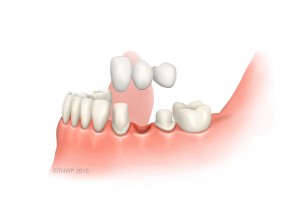
Dental implant or traditional bridge - which is best for me?
Dental implants and conventional bridges are two popular methods to replace missing teeth and restore your natural smile. The location of your missing tooth, the cost of treatment and how long restoration will take are important factors to consider before deciding which option is right for you. Your dentist will also look at your age, how many teeth are missing, the size of the gap, the condition of teeth next to the gap, your oral health and personal preference, before recommending appropriate treatment.
Contents
- What is a dental implant?
- What is a traditional dental bridge?
- How long does treatment take?
- Will my healthy teeth be affected?
- Which treatment preserves bone in my jaw?
- Which restoration is more cost efficient?
- How do I look after my tooth replacement?
- Which option will best restore my natural smile and chewing function?
There are several differences between dental implants and traditional bridges. In order to make an informed choice, it’s worth finding out more about each restorative option:
What is a dental implant?
A dental implant is fixed into the jawbone to replace the missing root. Usually made from high-grade titanium, a tooth implant looks like a screw. It is placed directly into the jaw and fuses with the jawbone, a process called osseointegration. After a period of healing, the implant supports a cosmetic, porcelain crown, which looks and feels like a real tooth.
What is a traditional dental bridge?
Dental bridges fill the gap of a missing tooth without replacing the root. A conventional three-unit bridge consists of crowns that are attached to your natural teeth on each side of the gap, with an artificial tooth in the middle.
How long does treatment take?
After a dental implant has been placed, in most cases dentists will want to leave the gum to heal and the implant to fuse (osseointegrate) with the jawbone before fitting permanent, replacement teeth. There is usually a period of healing lasting from six weeks to six months.
Treatment for a bridge may require two-to-three appointments over the space of a few weeks. Generally, the time required for a dental bridge to settle will be around three-to-four months. It may take longer for patients with high bone density or those who exercise vigorously. In this case a longer treatment plan will be required to avoid damage to gums and tooth roots.
Will my healthy teeth be affected?
Dental implants do not rely on natural teeth for support. A single implant is usually placed in the spot where you lost your original tooth without damaging remaining teeth.
Having a bridge entails the placement of crowns on the two adjoining teeth - therefore, the procedure involves three teeth, not one. Bridges require the preparation of often healthy adjacent teeth which need to be filed down to attach the bridge. This weakens the enamel and can lead to decay.
Which treatment preserves bone in my jaw?
Placing a dental implant can help to preserve bone. The artificial tooth root stimulates the jawbone when chewing and helps to preserve its density and volume, preventing bone loss over time.
Bone can shrink beneath a bridge due to lack of use which in turn can contribute to the instability of adjacent teeth. If you opt to have a bridge first with the intention of replacing it in a few years’ time with an implant, there is a risk that the bone underneath will have shrunk (resorbed) and will not be sufficient to support an implant without first undergoing bone grafting.
Which restoration is more cost efficient?
While the initial outlay of dental implants is typically higher than that of a bridge, their longer lifespan often makes them more cost-effective in the long term.
Bridges may need to be replaced from time to time due to wear and tear and to maintain a good aesthetic effect.
How do I look after my tooth replacement?
Dental implants can be cared for the same way as natural, healthy teeth by daily brushing, flossing and attending regular check-ups and hygienist appointments.
Bridges can be more challenging to clean due to the space between the artificial tooth and the gum line. If the bridge is connected to both supporting teeth either side, you will not be able to floss between them in the normal way. Your dentist or hygienist will show you how to clean under your bridge using a special dental floss.
Which option will best restore my natural smile and chewing function?
There are usually three main parts to a dental implant: the titanium post which fuses with your jawbone, the abutment which is a metal connector that screws into the implant and the ceramic crown, which attaches to and fits over the abutment. The overall structure mimics the anatomy of a natural tooth which makes dental implants a highly aesthetic option. In addition, because dental implants fuse (osseointegrate) with the jawbone, they offer excellent stability and function, allowing you to bite and chew with confidence.
Traditional bridges are also fabricated to look like natural teeth. Bridges will restore your smile and some of your natural chewing function. However, they cannot offer the same stability, durability and bone preservation qualities as implants. This is because standard bridges do not have the equivalent of a tooth root - they are simply connected to teeth each side of the gap. Sometimes the additional stress of supporting the bridge may contribute to the early failure of the adjacent teeth.
Dentists who provide implant treatment will be pleased to discuss your requirements and offer you a range of options for your budget and clinical needs. Browse our click4teeth UK directory of implant dentists and find out if dental implants are right for you.
